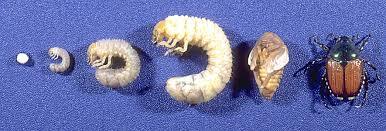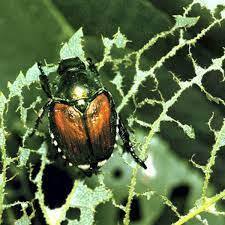Japanese Beetle: Difference between revisions
No edit summary |
No edit summary |
||
| Line 4: | Line 4: | ||
== Description == | == Description == | ||
Adult Japanese beetles can be recognized by their iridescent copper-colored elytra, they have a green thorax and head, with 5 patches of white hair on each side of the abdomen, and one pair on the last abdominal segment. The Japanese beetle adults are 0.6" (15mm) in length and 0.4" (10mm) in width. | Adult Japanese beetles can be recognized by their iridescent copper-colored elytra, they have a green thorax and head, with 5 patches of white hair on each side of the abdomen, and one pair on the last abdominal segment. The Japanese beetle adults are 0.6" (15mm) in length and 0.4" (10mm) in width. | ||
[[File: Japanese Beetle identify.jpg]] | |||
== Lifecycle == | == Lifecycle == | ||
The female adults lay their ova (eggs) individually or in small clusters near the surface of the [[soil]]. In about two weeks the larvae hatch and will feed on fine [[plant roots]] and other organic materials present. As the larvae mature and grow they become c-shaped grubs and will feed on larger plant roots. During this stage, the larvae can cause economic damage by destroying the roots of plants in pastures and turf. | The female adults lay their ova (eggs) individually or in small clusters near the surface of the [[soil]]. In about two weeks the larvae hatch and will feed on fine [[plant roots]] and other organic materials present. As the larvae mature and grow they become c-shaped grubs and will feed on larger plant roots. During this stage, the larvae can cause economic damage by destroying the roots of plants in pastures and turf. | ||
[[File: Japanese Beetle Life cycle.jpg]] | |||
Larvae hibernate in small patches of soil and emerge in the spring when soil temperatures rise. After breaking hibernation it takes 4-6 weeks for the larvae to pupate. The adults feed on leaf material aboveground by skeletonizing plant leaves. This feeding is harmful to the plant but it can recover if the feeding is not severe. The feeding of the beetles can be severe as they release pheromones to attract other beetles and can overwhelm plants skeletonizing all of its leaves. The beetles will alternate daily between mating, feeding, and ovipositing (laying ova). An adult female may lay as many as 40-60 ova in a lifetime. | Larvae hibernate in small patches of soil and emerge in the spring when soil temperatures rise. After breaking hibernation it takes 4-6 weeks for the larvae to pupate. The adults feed on leaf material aboveground by skeletonizing plant leaves. This feeding is harmful to the plant but it can recover if the feeding is not severe. The feeding of the beetles can be severe as they release pheromones to attract other beetles and can overwhelm plants skeletonizing all of its leaves. The beetles will alternate daily between mating, feeding, and ovipositing (laying ova). An adult female may lay as many as 40-60 ova in a lifetime. | ||
Revision as of 11:46, 5 May 2021
The Japanese Beetle (Popillia japonica) is a species of scarab beetle that is native to Japan. In Japan, it is not very destructive as they are controlled by natural predators, but in the United States, it is an invasive species that is known as a pest of about 300 species of plants. Adult beetles damage plants by skeletonizing the plant leaves, consuming the leaf material between the veins. They may also feed on any fruit on the plants. The subterranean larvae feed in the roots of plants primarily grasses.
Description
Adult Japanese beetles can be recognized by their iridescent copper-colored elytra, they have a green thorax and head, with 5 patches of white hair on each side of the abdomen, and one pair on the last abdominal segment. The Japanese beetle adults are 0.6" (15mm) in length and 0.4" (10mm) in width.

Lifecycle
The female adults lay their ova (eggs) individually or in small clusters near the surface of the soil. In about two weeks the larvae hatch and will feed on fine plant roots and other organic materials present. As the larvae mature and grow they become c-shaped grubs and will feed on larger plant roots. During this stage, the larvae can cause economic damage by destroying the roots of plants in pastures and turf.
 Larvae hibernate in small patches of soil and emerge in the spring when soil temperatures rise. After breaking hibernation it takes 4-6 weeks for the larvae to pupate. The adults feed on leaf material aboveground by skeletonizing plant leaves. This feeding is harmful to the plant but it can recover if the feeding is not severe. The feeding of the beetles can be severe as they release pheromones to attract other beetles and can overwhelm plants skeletonizing all of its leaves. The beetles will alternate daily between mating, feeding, and ovipositing (laying ova). An adult female may lay as many as 40-60 ova in a lifetime.
Larvae hibernate in small patches of soil and emerge in the spring when soil temperatures rise. After breaking hibernation it takes 4-6 weeks for the larvae to pupate. The adults feed on leaf material aboveground by skeletonizing plant leaves. This feeding is harmful to the plant but it can recover if the feeding is not severe. The feeding of the beetles can be severe as they release pheromones to attract other beetles and can overwhelm plants skeletonizing all of its leaves. The beetles will alternate daily between mating, feeding, and ovipositing (laying ova). An adult female may lay as many as 40-60 ova in a lifetime.
Most of the beetle's life is in the larval stage, with only 30-45 days spent as an adult beetle. Throughout most of the beetle's range, its life cycle takes one full year, but in extreme northern parts of its range as well as high altitude zones its development may take two years.
Range
Popillia japonica is native to Japan. However, it is an invasive species in North America. The first evidence of the beetle appearing in the United States was in 1916 in a nursery in New Jersey. The beetle larvae are thought to have entered the US in a shipment of iris bulbs prior to 1912 when inspections of commodities that entered the country began. Beetles have been detected in airports on the west coast of the US since the 1940s. Since 2015 only 9 western US states were considered free of Japanese beetles. The spread of the beetle population to the western US has been deterred by APHIS (Animal and Plant Health Inspection Service) a part of the U.S. Department of Agriculture. APHIS maintains the Japanese Beetle Quarantine and Regulations. These regulations protect the agriculture of the western US and prevent the human-assisted spread of the beetle from the Eastern US. These regulations specifically protect the states of Arizona, California, Colorado, Idaho, Montana, Nevada, Oregon, Utah, and Washington.
P. japonica have also been found in China, Russia, Portugal, and Canada.
Control methods
Row coverings can be used to protect plants from the Japanese beetles during the 6 to 8 week feeding period when the adult beetles are feeding which can vary depending on the temperature. This will keep pollinators out as well, so hand-pollinating may need to be implemented, or the row covers can be removed after the feeding period is over.
Hand-picking the beetles is the most effective way to remove the beetles but is not practical for large plots. In home gardens this can be the most effective. For this method a jar filled with soapy water can be used to dispatch the picked off beetles.
Geraniums can be used to protect other vulnerable plants. The beetles are attracted to geraniums, when they eat the blossoms they get dizzy from the natural chemicals in the geranium and fall off the plant. They can then be collected from the ground and disposed of.
Japanese beetle traps can also be used but they can attract more beetles as well. They are best used in large populations of beetles, on the border of agricultural areas, and placed downwind. Even though the traps are effective they can be detrimental if placed wrong as they can attract more beetles to the plants nearby the traps.
There are a few biological controls that can be used to remove the beetles. Milky spores, a fungal disease can be introduced to the soil to control the larvae population. The grubs will ingest the spores as they feed in the soil and they will reproduce inside the larvae and kill the larvae in 7-21 days. The spores remain viable in the soil for years, which is important as a spore count must be up for 2 to 3 years to be effective. This treatment can be very expensive as all soil within five-eighths of a mile needs to be treated for good control, and may need to be treated multiple times to keep the spore count high enough in the soil to be effective. Parasitic wasps, specifically Tiphia vernalis, will attack larvae, but they are not very effective in reducing the beetle population as a whole.
Hostplants
The larvae of Japanese beetles feed on the roots of many genera of grasses, the adults consume on leaves of a much wider range of hosts, including many common crops: bean, cannabis, strawberry, tomato, grape, hop, rose, cherry, corn and many more.
List of adult beetle hostplant genera
- Abelmoschus
- Acer (maple)
- Aesculus (horse chestnut)
- Asimina (pawpaw)
- Asparagus
- Aster
- Buddleja
- Calluna
- Canna
- Cannabis sativa
- Castanea (sweet chestnut)
- Cirsium (thistle)
- Cosmos
- Daucus (carrot)
- Dendranthema
- Digitalis
- Dolichos
- Echinacea (coneflower)
- Hibiscus
- Humulus (hop)
- Hydrangea
- Ilex (holly)
- Ipomoea (morning glory)
- Iris
- Juglans (walnut)
- Ligustrum (privet)
- Malus (apple, crabapple)
- Malva (mallow)
- Mentha (mint)
- Myrica
- Ocimum (basil)
- Oenothera (evening primrose)
- Parthenocissus
- Phaseolus
- Platanus (plane)
- Polygonum (Japanese knotweed)
- Populus (poplar)
- Prunus (plum, peach)
- Quercus (oak)
- Ribes (gooseberry, currants, etc.)
- Rheum
- Rosa (rose)
- Rubus (raspberry, blackberry, etc.)
- Salix (willows)
- Sassafras
- Solanum (nightshades, including potato, tomato, eggplant)
- Spinacia (spinach)
- Syringa (lilac)
- Thuja (arborvitae)
- Tilia (basswood, linden, UK: lime)
- Toxicodendron (poison oak, poison ivy, sumac)
- Ulmus (elm)
- Vaccinium (blueberry)
- Vitis (grape)
- Wisteria
- Zinnia
Gallery
References
1. "Popillia japonica | WY Cooperative Agriculture Pest Survey | University of Wyoming".
2. Fleming, WE (1972). "Biology of the Japanese beetle". USDA Technical Bulletin. 1449.
3. "Popillia Japonica (Japanese Beetle) – Fact Sheet". Canadian Food Inspection Agency. 19 February 2014. Archived from the original on 4 December 2010. Retrieved 28 September 2015.
4. "Managing the Japanese Beetle: A Homeowner's Handbook". U.S. Department of Agriculture, Animal and Plant Health Inspection Service. May 2015. Retrieved 28 September 2015.
5. Hahn, J., J. Weisenhorn, and S. Bugeja. (n.d.). "Japanese beetles in yards and gardens." https://extension.umn.edu/yard-and-garden-insects/japanese-beetles.


